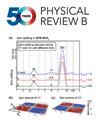Controllable trions in buckled two-dimensional materials
IF 3.7
2区 物理与天体物理
Q1 Physics and Astronomy
引用次数: 0
Abstract
We predict the formation of intravalley and intervalley controllable trions in buckled two-dimensional (2D) materials such as silicene, germanene, and stanene monolayers in an external electric field. A study is performed within the framework of a nonrelativistic potential model using the method of hyperspherical harmonics (HH). We solve the three-body Schrödinger equation with the Rytova-Keldysh potential by expanding the wave functions of a trion in terms of the HH. A resultant system of coupled differential equations is solved numerically. Controllable ground-state energies of intravalley and intervalley trions by the external electric field are presented. The dependencies of the binding energy (BE) of trions in silicene, germanene, and stanene as a function of the electric field are qualitatively similar. BEs of trions formed by and excitons have a non-negligible difference that increases slightly as the electric field increases. It is demonstrated that trion BEs can be controlled by the external electric field, and the dielectric environment has a significant effect on the trion BE. The capability to control the BE and compactness of trions in buckled 2D materials by an external electric field suggests a possible trions crystallization in Xenes.

屈曲二维材料中的可控三离子
我们预测了硅烯、锗烯和链烷烯单层等降压二维(2D)材料在外加电场中形成的谷内和谷间可控三离子。研究在非相对论势模型的框架内使用超球谐波(HH)方法进行。我们利用 Rytova-Keldysh 势,通过以 HH 展开三元体的波函数来求解三体薛定谔方程。我们对由此产生的耦合微分方程系统进行了数值求解。提出了通过外部电场控制谷内和谷间三离子的基态能量。硅烯、锗烯和链烷烯中三离子的结合能(BE)与电场的函数关系在本质上是相似的。由 A 和 B 激子形成的三离子结合能具有不可忽略的差异,并随着电场的增加而略有增加。实验证明,三离子的 BE 可由外部电场控制,而电介质环境对三离子的 BE 有显著影响。通过外电场控制屈曲二维材料中三元子的BE和致密性的能力表明,三元子可能在氙中结晶。
本文章由计算机程序翻译,如有差异,请以英文原文为准。
求助全文
约1分钟内获得全文
求助全文
来源期刊

Physical Review B
物理-物理:凝聚态物理
CiteScore
6.70
自引率
32.40%
发文量
0
审稿时长
3.0 months
期刊介绍:
Physical Review B (PRB) is the world’s largest dedicated physics journal, publishing approximately 100 new, high-quality papers each week. The most highly cited journal in condensed matter physics, PRB provides outstanding depth and breadth of coverage, combined with unrivaled context and background for ongoing research by scientists worldwide.
PRB covers the full range of condensed matter, materials physics, and related subfields, including:
-Structure and phase transitions
-Ferroelectrics and multiferroics
-Disordered systems and alloys
-Magnetism
-Superconductivity
-Electronic structure, photonics, and metamaterials
-Semiconductors and mesoscopic systems
-Surfaces, nanoscience, and two-dimensional materials
-Topological states of matter
 求助内容:
求助内容: 应助结果提醒方式:
应助结果提醒方式:


